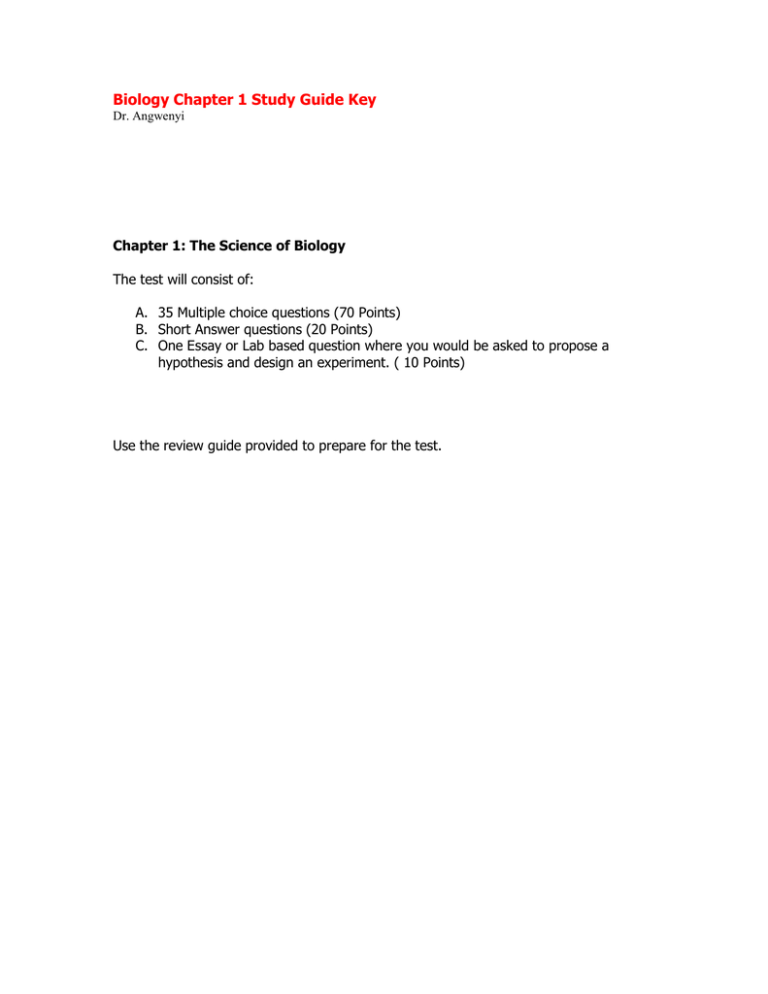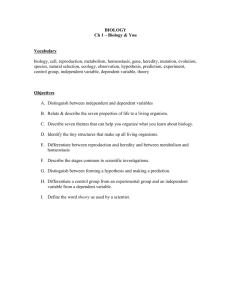Biology Chapter 1 Study Guide Key
advertisement

Biology Chapter 1 Study Guide Key Dr. Angwenyi Chapter 1: The Science of Biology The test will consist of: A. 35 Multiple choice questions (70 Points) B. Short Answer questions (20 Points) C. One Essay or Lab based question where you would be asked to propose a hypothesis and design an experiment. ( 10 Points) Use the review guide provided to prepare for the test. Biology Study Guide Chapter 1- The Science of Biology 1. 2. 3. 4. 5. The variable that Is deliberately changed is the independent variable. The vast majority of organisms reproduce sexually. The smallest units that are considered to be alive are cells. The metric system is based on multiples of 10. The work of scientists begins with Observations, experiments, from which we gather data. 6. How does science differ from art & history? (because it relies on facts or evidence) 7. What is “data” in a scientific experiment? The evidence that is collected. 8. Define hypothesis and be able to give or recognize an example. 9. A hypothesis may arise from: (list three things): observations, questions, collected data. 10. A hypothesis is useful only if it can be tested. 11. Know the three types of variables & know the examples of those variables from Redi’s experiment. Independent, dependent, controlled variable. 12. A controlled experiment allows the scientist to ISOLATE & TEST a SINGLE variable. 13. Why do scientists publish the details of their experiments? For Peer review. 14. When enough experimental data support a hypothesis, the hypothesis becomes a(an) theory. 15. Theory-a well tested explanation that unifies a broad range of observations. 16. Biology is the study of life. 17. Know the 8 characteristics of living things and be able to recognize examples of each: Cells, DNA, Evolve, homeostasis, use energy, grow and develop, stimulus response, metabolism 18. Cell Specialization allows cells to perform different functions. 19. Homeostasis--process by which organisms keep their INTERNAL conditions RELATIVELY STABLE. 20. Biosphere-refers to the land, water & air on Earth. (*Look at levels of organization for this answer!): (Species-population-community-ecosystem-biomebiosphere) 21. Population-group of organisms of ONE type living in ONE PLACE. 22. List the levels of organization from the SMALLEST to the LARGEST: Cells-TissuesOrgans-Organ systems-Organism. 23. In the metric system, the basic unit of length is the meter. 24. On the Celsius temperature scale, how many degrees are between freezing & boiling points of water? 100 25. The LITER measures volume & the GRAM measures mass in the metric system. 26. The use of a compound light microsope can magnify objects up to 1000 times. 27. What is a compound microscope? Use multiple lenses to magnify objects. 28. Colony-groups of cells that develops from a single original cell. 29. Centrifuge-the BEST instrument for separating the LIQUID portion of blood from the solid portions of whole blood. 30. ***Know all safety rules for lab/science! 31. Define QUALitative observation & QUANTitative observation and give an example of each: Qualitative describes and Quantitative measures 32. What is Spontaneous Generation? Arising from nothing or 33. WHO finally settled the argument over spontaneous generation? Francesco Redi 34. Metabolism -the chemical reactions through which an organism builds up or breaks down materials as it carries out its life processes. 35. CAN a theory change over time? EXPLAIN your answer IN ESSAY FORM!! Yes, new evidence. 36. USING SCIENCE SKILLS…you will be given an experiment…and asked to determine the control and the variable for the experiment… 37. What are the 3 Goals of Science and why is this important? 38. What are the steps of the Scientific method? See class notes 39. Complete the Chart below Term Definition Example Controlled Experiment An experiment where To determine the effect only one variable of nitrogen on plant changes. growth, all factors will be kept the same except the amount of nitrogen. Controlled Variable Manipulated variable All parts of the All variables such as experiment that are the temp, soil type, light will same. be kept the same. The variable that is Nitrogen is the being deliberately manipulated variable. changed. Responding variable What is being Plant growth is the measured…this is also responding variable- you known as Data. can measure how much the plant grows and compare with those without nitrogen. Control The experiment ran How the plant grows under normal conditions. under normal conditions without manipulating the variable. 40. How do observations and inferences help scientists to make a hypothesis? Observations are the basis for hypothesis formulation which lead to an experiment from which data can be collected, and hence inferences can be made using that evidence. 41. Explain how a hypothesis different from a theory? Hypothesis is simply a possible explanation for an observation and has not been tested whereas a theory is a broad range of tested hypotheses about an observed phenomena. 42. Define the term biology: biology is the study of life. 43. What are the eight characteristics of life? Which is the most important characteristic and why?: Ability to reproduce, growth and development, universal genetic code, evolution, made of cells, metabolism, homeostasis, respond to an external stimulus. Reproduction is the most important because without it species extinction can result. 44. Provide an example of homeostasis and explain why is essential for living organisms to maintain a stable internal environment. Human body temperature has to be regulated within a certain range in order for cellular functions to occur normally. If it gets too hot, sweating results as a way to cool the body temperature. This process is internally controlled. 45. Complete the following metric conversions. a. 65 mL = 0.065 L. b. 548 km = 54,800,000 cm c. 0.855 g = 855 mg d. 550 cm = 5.5 m e. 995 mm = 0.995 m 46. Calculate total magnification for a specimen observed at an objective power lens of X40 and eyepiece magnification of X10. X400.






